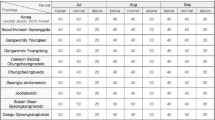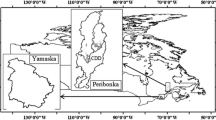Abstract
Streamflow forecasts are essential for optimal management of water resources for various demands, including irrigation, fisheries management, hydropower production and flood warning. Despite operational application of Ensemble Streamflow Prediction (ESP) for long-range streamflow forecasts in United States of America by the National Weather Service River Forecast System, no such approach has been explored in New Zealand. The objective of the present paper is to explore ESP-based forecasts in New Zealand catchments, highlighting its capability for seasonal flow forecasting. In this paper, a probabilistic forecast framework based on ESP technique is presented, with the basic assumption that future weather patterns will reflect those experienced historically. Hence, past forcing data (input to hydrological model) can be used with the current initial condition of a catchment to generate an ensemble of flow predictions. In the present study employs the ESP-based approach using the TopNet hydrological model with a range of past forcing data and current initial conditions. An ensemble stream flow predictions which provide probabilistic hydrological forecasts, reflecting the intrinsic uncertainty in climate, with lead time up to three months is presented for the Rangitata, Ahuriri, and Hooker and Jollie catchments in South Island, New Zealand. Verification of the forecast over the period 2000-2010 indicates a Ranked Probability Skill Score of 23 to 69 % (over climatology) across the four catchments. In general, improvement in ESP forecasting skill over climatology is greatest in summer for all catchments studied. The ESP based forecast exhibited higher skill for a greater percentage of the forecasting period than climatology. As a result, the ESP forecast can provide better over all information for integrated water resources management purpose. ESP-based forecasts using the TopNet hydrological model have potential as tools for water resource management in New Zealand catchments.








Similar content being viewed by others
References
Avilés A, Célleri R, Paredes J, Solera A (2015) Evaluation of markov chain based drought forecasts in an Andean regulated River Basin using the skill scores RPS and GMSS. Water Resour Manag 29(6):1949–1963
Bandaragoda C, Tarboton DG, Woods R (2004) Application of TOPNET in the distributed model intercomparison project. J Hydrol 298(1–4):178–201
Bárdossy A, Singh SK (2008) Robust estimation of hydrological model parameters. Hydrol Earth Syst Sci 12:1273–1283
Brandon D, Charge HI (2005) Using NWSRFS ESP for making early outlooks of seasonal runoff volumes into Lake Powell, Special Session on Hydrology of Arid and Semi-Arid Regions AMS Annual Meeting, San Diego, CA, Jan 9, pp. 2005
Brier GW (1950) Verification of forecasts expressed in terms of probability. Mon Weather Rev 78(1):1–3
Caraway NM (2010) Stochastic weather generator based ensemble streamflow forecasting. University of Colorado, Colorado, 166 pp
Chen J, Brissette FP (2015) Combining stochastic weather generation and ensemble weather forecasts for short-term streamflow prediction. Water Resour Manag 29(9):3329–3342
Clark MP, Rupp DE, Woods RA, Zheng X, Ibbitt RP, Slater AG, Schmidt J, Uddstrom MJ (2008) Hydrological data assimilation with the ensemble Kalman filter: Use of streamflow observations to update states in a distributed hydrological model. Adv Water Resour 31(10):1309–1324
Day GN (1985) Extended streamflow forecasting using NWSRFS. J Water Resour Plan Manag 111(2):157–170
Elmore KL (2005) Alternatives to the chi-square test for evaluating rank histograms from ensemble forecasts. Weather Forecast 20(5):789–795
Epstein ES (1969) A scoring system for probability forecasts of ranked categories. J Appl Meteorol 8(6):985–987
Franz KJ, Hartmann HC, Sorooshian S, Bales R (2003) Verification of National Weather Service ensemble streamflow predictions for water supply forecasting in the Colorado River basin. J Hydrometeorol 4(6):1105–1118
Franz KJ, Hogue TS, Sorooshian S (2008) Snow model verification using ensemble prediction and operational benchmarks. J Hydrometeorol 9(6):1402–1415
Gado Djibo A, Karambiri H, Seidou O, Sittichok K, Paturel JE, Saley HM (2015) Statistical seasonal streamflow forecasting using probabilistic approach over West African Sahel. Nat Hazards 79(2):699–722
Garen DC (1992) Improved techniques in regression-based streamflow volume forecasting. J Water Resour Plan Manag 118(6):654–670
Guzha AC, Hardy TB (2009) Application of the distributed hydrological model, TOPNET, to the Big Darby Creek Watershed, Ohio, USA. Water Resour Manag 24(5):979–1003
Hamill TM (2001) Interpretation of rank histograms for verifying ensemble forecasts. Mon Weather Rev 129(3):550–560
Hamlet AF, Lettenmaier DP (1999) Columbia River streamflow forecasting based on ENSO and PDO climate signals. J Water Resour Plan Manag 125(6):333–341
Hudlow MD (1988) Technological developments in real-time operational hydrologic forecasting in the United States. J Hydrol 102(1–4):69–92
Jiang S, Ren L, Hong Y, Yang X, Ma M, Zhang Y, Yuan F (2014) Improvement of multi-satellite real-time precipitation products for ensemble streamflow simulation in a middle latitude Basin in South China. Water Resour Manag 28(8):2259–2278
Li H, Luo L, Wood EF et al. (2009) The role of initial conditions and forcing uncertainties in seasonal hydrologic forecasting. J Geophys Res: Atmos (1984–2012), 114(D4)
Murphy AH (1969) On the ranked probability skill score. J Appl Meteorol 8(6):988–989
Nash JE, Sutcliffe J (1970) River flow forecasting through conceptual models part I—a discussion of principles. J Hydrol 10(3):282–290
Newsome PFJ, Wilde RH, Willoughby EJ (2000) Land resource information system spatial data layers, technical report. Landcare Research NZ Ltd., Palmerston North
Piechota TC, Chiew FH, Dracup JA, McMahon TA (1998) Seasonal streamflow forecasting in eastern Australia and the El Niño–Southern Oscillation. Water Resour Res 34(11):3035–3044
Rajagopalan B, Grantz K, Regonda S (2005) Ensemble streamflow forecasting: methods and applications. Taylor and Francis, pp. 97-116
Robertson DE, Wang Q (2012) A Bayesian approach to predictor selection for seasonal streamflow forecasting. J Hydrometeorol 13(1):155–171
Robertson DE, Wang QJ (2013) Seasonal Forecasts of Unregulated Inflows into the Murray River, Australia. Water Resour Manag 27(8):2747–2769
Robertson D, Pokhrel P, Wang Q (2013) Improving statistical forecasts of seasonal streamflows using hydrological model output. Hydrol Earth Syst Sci 17(2):579–593
Singh VP, Cui H (2015) Entropy theory for streamflow forecasting. Environ Process 2(3):449–460
Snelder TH, Biggs BJF (2002) Multiscale river environment classification for water resources management. J Am Water Resour Assoc 38(5):1225–1239
Souza Filho FA, Lall U (2003) Seasonal to interannual ensemble streamflow forecasts for Ceara, Brazil: applications of a multivariate, semiparametric algorithm. Water Resour Res 39(11):1307
Svensson C (2016) Seasonal river flow forecasts for the United Kingdom using persistence and historical analogues. Hydrol Sci J 61(1):19–35
Tait A, Woods R (2007) Spatial interpolation of daily potential evapotranspiration for New Zealand using a spline model. J Hydrometeorol 8(3):430–438
Twedt TM, Burnash RJ, Ferral RL et al. (1978) Extended streamflow prediction during the California drought. Proc, Western Snow Conf
Weigel AP, Liniger MA, Appenzeller C (2007) The discrete brier and ranked probability skill scores. Mon Weather Rev 135(1):118–124
Wood AW, Lettenmaier DP (2008) An ensemble approach for attribution of hydrologic prediction uncertainty. Geophys Res Lett 35(14):L14401
Wood AW, Schaake JC (2008) Correcting errors in streamflow forecast ensemble mean and spread. J Hydrometeorol 9(1):132–148
Acknowledgments
The author would like to thank Scott Graham and Christian Zammit for their help during this study. The author would like to thank Meridian energy for providing data. The author gratefully acknowdge the detailed and constractive comments made by the associated editor and two anonymous reviewer which greatly helped improve this article. This work was funded by the New Zealand Ministry of Science and Innovation, Contract number C01X0812.
Author information
Authors and Affiliations
Corresponding author
Rights and permissions
About this article
Cite this article
Singh, S.K. Long-term Streamflow Forecasting Based on Ensemble Streamflow Prediction Technique: A Case Study in New Zealand. Water Resour Manage 30, 2295–2309 (2016). https://doi.org/10.1007/s11269-016-1289-7
Received:
Accepted:
Published:
Issue Date:
DOI: https://doi.org/10.1007/s11269-016-1289-7




